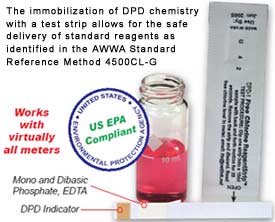A reagent (chemical) known affectionately as DPD has reigned supreme as the ‘best’ way to test for the presence of free or total chlorine in water for quite a while now. What most folks don’t know is that someone has FINALLY found a way to make using DPD for chlorine testing even easier.
DPD ReagentStrips: Look like test strips, but function like a totally convenient way to precisely administer measured amounts of DPD into a 10 mL water sample. All the reagents, buffers and indicators come neatly impregnated on the pads at the end of an ergonomic PVC strip.
Simply swish the pads around in your sample for 20 seconds, remove the strip, throw it away, and read your sample in your preferred colorimeter. DPD ReagentStrips fall under the guidelines of EPA Compliance and may, in most cases, be used in place of all other DPD methods. . . and they don’t require MSDS.
Previously, DPD came in one of three forms: powder pillow, tablet or liquid. Each has its benefits. . . and each has its downfalls.
Powder Pillow: The most popular form of DPD. Precise amounts of the reagent come in single-dose foil ‘pouches’ that the user tears open and pours into their sample. Sounds like a great idea, yes, but try using these things in a ‘wet’ or windy environment. Anyone who works in the field will know what that means. MSDS required.
Liquid DPD: Cheap as can be, but with that inexpensive price comes an incredibly short shelf-life compared to other DPD delivery systems. MSDS required.
DPD Tablets: Very inexpensive, very stable. Great way to deliver exact amounts of DPD into samples, except for one small problem: DPD tablets do not dissolve smoothly or easily in cold or hard water. In either type of water, DPD tablets typically leave undissolved solids floating in the sample and when analyzing water samples using colorimeters the suspended solids can cause erroneous readings.
Fast Dissolving DPD Tablets: Same reagent dispensing mechanism as regular DPD tablets, but they dissolve faster. These, too, may leave undissolved materials in samples such as elements of the binding agent(s) which held the tablets together prior to immersion in the sample.
UPDATE: For certain free chlorine testing applications, states now have the ability to approve the use of EPA Approved SenSafe(tm) Free Chlorine Check test strips. Please consult with your State and/or Local Health Departments to see if your State has approved their use. Benefits include faster test times and no monochloramine interference.





